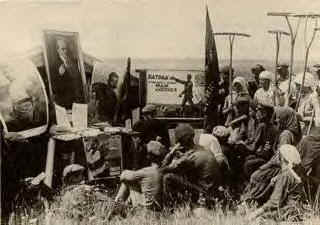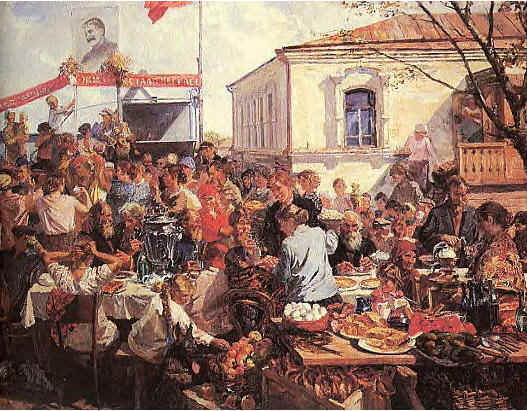|
| |||||||||||||||||||||||||
|
Summary Stalin's desire to modernise agriculture led him to collectivise the farms, amalgamating them and putting them totally under state control. In the end, this did lead to more efficient farming and increased production, but in the short term it involved him in a 'war' with the kulaks, and a disastrous fall in output, which led to famine.
|
Going DeeperThe following links will help you widen your knowledge: Old Bitesize - simple intro (pdf) Why Did Stalin Introduce Collectivisation? - Save My Exams Were Stalin's Economic Policies a Success? - Save My Exams Essay - by historian Lewis Siegelbaum
Dekulalisation - horrific
Old textbook accounts of Collectivisation PJ Larkin, Revolution in Russia (1965)
| ||||||||||||||||||||||||
Why did Stalin do it?[Seven Worries Necessitated Collectivising Farms Into Kolkhozy]
1. Soviet agriculture was backwardOld-fashioned/ inefficient/ no machinery/ too small/ subsistence (only grew enough for themselves). 2. Workers were needed for IndustryIf the USSR was to become modern/ industrial, peasants needed to migrate to work in the towns. 3. NEP was not workingBy 1928, the USSR was 20 million tons of grain short to feed the towns. 4. Cash Crops were neededIf the USSR was to industrialise, peasants needed to grow cash crops (eg grain) which could be exported to raise money to buy foreign machinery and expertise. 5. Food was needed for workers in the townsEssential if the Five-Year Plans were to succeed. 6. IdeologyJust as you did for Stalin's Terror, you might do well to glance back at the page on Bolshevik Russia to refresh your mind about the Bolsheviks' relations with the peasants. For the Bolsheviks, the peasants were not part of the proletariat – they were unenlightened, resistant and/or downright hostile to true socialism ... and the Bolsheviks believed that they needed to be moved towards a socialist society, by propaganda/education if possible, by force/terror if necessary. Lenin had been 'defeated' in 1921. There was unfinished business here. 7. Kulaks opposed CommunismThe Kulaks opposed Communism – they liked their private wealth. They hid food from the government collectors. Also they were influential, and led peasant opinion. Stalin wanted to destroy them.
|
Collectivisation Timeline 1927–1939 1927 Stalin announced collectivisation – peasants asked to take part voluntarily. Ignored. 1928 Food shortages. Police confiscated food and took it to the towns. 1929 Stalin announced compulsory collectivisation, enforced by the army. The peasants burned their crops and barns, and killed their livestock. 1930 Famine. Stalin paused collectivisation. Peasants were allowed to own a small plot of land. 1931 Collectivisation re-started. By 1932 two-thirds of the villages had been collectivised. More resistance, burning/ killing. Meanwhile, the government took more food for the towns, so: 1932-3 Famine, esp. in Ukraine (the Holodomor, where 5 million died). Stalin blamed, and declared war on, the Kulaks – their land was taken and they were shot/ sent to labour camps in Siberia/ whole villages surrounded and killed. 1934 All 7 million kulaks ‘eliminated’. 1939 99% of land collectivised; 90% peasants live on one of ¼ million kolkhozy; 4,000 state farms. Farming run by government officials.
|
||||||||||||||||||||||||
What was 'Collectivisation?Stalin's 1929 order simply required farmers to pool their land and their equipment, and to work in future under the orders of the collective farm committee (which was under the control of the Communist Party). No other details – such as how the workers would be paid – were given, and in 1930 Stalin even sent a contradictory order that 'small vegetable gardens, dwelling houses, some dairy cattle, small livestock poultry etc. are not socialised' (at which point, many farmers withdrew from the collectives). Later rules, however, enforced collectivisation, prescribed punishments for 'enemies of the collective farms' (such as the kulaks), stipulated that 90% of the produce had to go to the state (with 10% left to feed the collective), and set up Motor Tractor Stations to provide mechanisation.
|
Did You KnowIn the 1990s, when Communism collapsed, many collective farms were broken up and the land shared out between the members. However, in many places, the people preferred to keep their collective farms voluntarily – they liked the security and shred responsibility they offered.
|
||||||||||||||||||||||||
Source A
Bolshevik teachers instruct a less-than-enthusiastic group of peasants about the benefits of collectivisation
|
Source B
Peasants celebrating on a collectivised farm – a propaganda painting from 1937
|
||||||||||||||||||||||||
Successes...[Quite Modern Government Tries Collectivisation]
1. Quarter of a million kolkhozy99% of Russia had been collectivized . 2. More modern methodsNew methods/ tractors/ fertilisers/ large-scale/ new attitudes (trying to produce as much as possible). 3. GrainBy 1937, 97 million tonnes were produced, supplying more food to the towns PLUS cash crops for export. 4. Town-workers17 million peasants left the countryside to work in the towns, 1928-37. 5. Communists control completelyOfficials ran farming. Peasants obeyed the Party, through enthusiasm or fear. Stalin had all power.
|
... and Failures[Sad Foolish Kulaks]
1. StockNumber of livestock fell dramatically:
2. FamineMillions of people died in the Famine of 1932-33, esp. the 'Holodomor' in Ukraine (5 million died). 3. KulaksThe Kulaks were eliminated as a class: incalculable human suffering.
|
||||||||||||||||||||||||
Source CThe collective farms, despite all their inefficiencies, did grow more food than the tiny, privately-owned holdings had done. 30–40 million tons of grain was produced every year. Collectivisation also meant the introduction of mechanisation into the countryside where, previously, the peasants had never seen a tractor. Now, two million previously-backward peasants learned to drive a tractor. New methods of farming were taught by 110,000 engineering and agricultural experts. The countryside was indeed transformed. E Roberts, Stalin: Man of Steel (1968).
|
Source DStock was slaughtered every night in Gremyachy Log. Hardly had dusk fallen when the muffled, short bleats of sheep, the death-squeals of pigs, or the lowing of calves could be heard. Both those who had joined the kolkhoz and individual farmers killed their stock. Bulls, sheep, pigs, even cows were slaughtered, as well as calves for breeding. The stock of Gremyachy was halved in two nights. The dogs began to drag entrails about the village; cellars and barns were filled with meat ... ‘Kill, it’s not ours any more ...’ ‘Kill, they'll take it for meat anyway ...’ ‘Kill, you won’t get meat in the kolkhoz ...’ crept the insidious rumours. And they killed... Mikhail Sholokov, The Soild Upturned (1932),
a novel.
|
||||||||||||||||||||||||
Consider:1. Write a brief answer to describe collectivisation, and how it was introduced, 1927-33. 2. Why did Stalin want to introduce collectivisation? 3. Explain why collectivistion encountered resistance. 4. Write a brief answer to describe the consequences of collectivisation.
|
|
|
|
|
|
Spotted an error on this page? Broken link? Anything missing? Let me know. |
|

